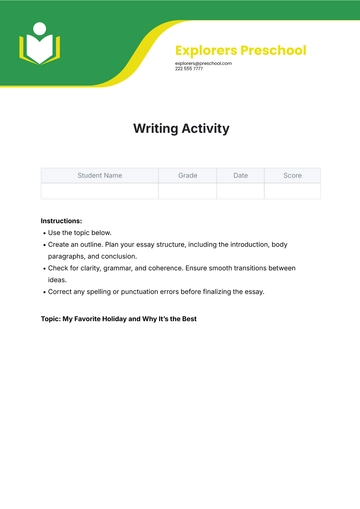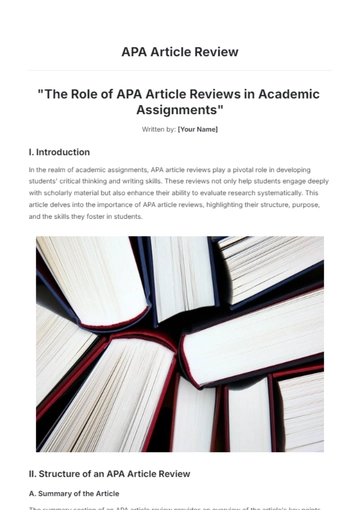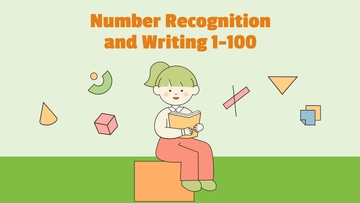Free Abstract Writing Journal Article

Abstract Writing: A Comprehensive Guide
Written By: [Your Name]
Introduction
Abstract writing plays a crucial role in academic and professional writing, serving as a concise summary of research, projects, or papers. The abstract is often the first part of a paper that readers encounter, making it a critical component in determining whether the rest of the content is worth reading. This article will explore the essential components, types, and strategies for writing an effective abstract, including its significance in academic discourse.
Purpose and Importance of Abstracts
The abstract serves several functions, including providing a summary of the key points of a paper, helping readers quickly decide whether the entire work is relevant to their interests, and giving a snapshot of the study’s scope, methods, and conclusions. Abstracts are indispensable in scholarly databases, journals, and conference proceedings, where time-pressed readers rely on them to assess the relevance of longer works.
Benefits of an Effective Abstract
Clarity and Brevity: The abstract helps distill complex research into digestible information, allowing readers to grasp the essence of the study without wading through lengthy details.
Increased Accessibility: An effective abstract broadens the reach of the work, making it easier for scholars, researchers, and practitioners to find through keyword searches.
Aiding in the Selection Process: Editors, reviewers, and readers frequently use abstracts to make decisions about publication or further investigation, making it a powerful tool in academic communication.
Types of Abstracts
Abstracts generally fall into two broad categories: descriptive and informative, although some disciplines may use other formats such as structured abstracts.
Descriptive Abstracts
Descriptive abstracts provide an overview of the topics covered in the paper without giving detailed results or conclusions. These abstracts typically include the research purpose and scope but do not offer a summary of findings or the impact of the research.
Length: Usually shorter, around 100-150 words.
Components: Includes the problem statement, methods, and purpose, but omits conclusions and detailed results.
Usage: Often used in humanities and social sciences where the depth of argumentation is the focus.
Informative Abstracts
Informative abstracts are more comprehensive, providing a concise version of the entire paper, including the results and conclusions. This type is commonly used in scientific and technical fields where the research findings are pivotal.
Length: Can range from 150-300 words.
Components: Summarize the study’s purpose, methodology, key results, and conclusions.
Usage: Ideal for empirical research, allowing readers to get a full picture of the research without reading the entire article.
Structured Abstracts
A structured abstract uses specific headings (e.g., Background, Methods, Results, Conclusions) to organize the information systematically. It is prevalent in medical, psychological, and other empirical research fields where precision is required.
Length: 200-400 words.
Components: Divided into sections such as Introduction, Objectives, Methods, Results, and Conclusions.
Usage: Particularly common in medical and psychological journals, where the structured presentation of information is essential for quick assimilation.
Key Components of an Abstract
Although the structure may vary depending on the type and discipline, an effective abstract generally contains five critical elements.
1. Background/Introduction
The background provides context for the research. It briefly outlines the problem, research question, or purpose of the study. This section answers the "why" of the research.
Example: "Climate change has increasingly impacted global agricultural output, posing significant challenges to food security in vulnerable regions."
2. Objectives or Purpose
This section states the primary goals or objectives of the research. It explains what the study seeks to achieve, offering clarity on the research focus.
Example: "This study aims to analyze the relationship between soil degradation and agricultural productivity in Southeast Asia over the last two decades."
3. Methods
The methods section provides a concise summary of the research design, methodology, or approach used. It may include descriptions of experimental procedures, data collection, or analytical tools.
Example: "Using a mixed-method approach, this study employed satellite imagery and field surveys to assess the impact of soil erosion on crop yields."
4. Results
The results section highlights the key findings of the research. It may include statistical outcomes, observed trends, or qualitative insights, depending on the type of research.
Example: "Results indicate a significant correlation between increased soil degradation and a 15% reduction in crop yields over the last decade."
5. Conclusion
The conclusion provides the implications or impact of the findings. It often includes a brief statement on how the research contributes to the existing body of knowledge or its potential real-world applications.
Example: "The study’s findings highlight the urgent need for sustainable farming practices in Southeast Asia to mitigate the effects of climate change on agriculture."
Writing Strategies for an Effective Abstract
Writing an abstract involves balancing clarity, brevity, and comprehensiveness. Below are some strategies to consider:
1. Write the Abstract Last
Although it appears at the beginning of a paper, the abstract is typically written after the research is complete. Writing the abstract last ensures that it accurately reflects the content and findings of the study.
2. Use Active Voice
An active voice enhances clarity and directness. Instead of saying "The results were analyzed," say "We analyzed the results."
3. Be Concise
Abstracts are inherently short, and every word matters. Avoid unnecessary details, jargon, or excessive background information. Stick to key points and be mindful of the word limit.
4. Include Keywords
Incorporating relevant keywords enhances the discoverability of the abstract in digital databases. Keywords should be closely related to the research topic and field of study.
5. Avoid Citations
Typically, abstracts should not contain citations since they are meant to summarize original work. Citing other research in an abstract may distract from the primary focus.
6. Revise for Accuracy and Readability
After drafting the abstract, revisit it to ensure that it accurately reflects the paper's content. Pay attention to flow and readability, ensuring that it is accessible to a broad audience, including those unfamiliar with the subject matter.
Common Pitfalls in Abstract Writing
While writing an abstract, it’s easy to fall into certain traps that can compromise its effectiveness. Some of the common pitfalls include:
1. Overloading with Details
Including too much information, especially minor details or overly technical explanations, can overwhelm the reader. The abstract should only contain essential information that directly contributes to the understanding of the study.
2. Vagueness or Lack of Specificity
On the other end of the spectrum, some abstracts are too vague, failing to provide a clear picture of the study. Be specific about the research question, methods, and results.
3. Ignoring the Word Limit
Adhering to the word limit is crucial. Going over the limit can result in the abstract being cut off in publication databases, while a too-short abstract may fail to provide sufficient information.
4. Poor Grammar and Formatting
Errors in grammar, spelling, or formatting can detract from the professionalism of the abstract. Meticulous proofreading is essential to ensure that the abstract is polished and error-free.
Conclusion
Writing an effective abstract requires a balance between brevity, clarity, and detail. By understanding the purpose of an abstract, identifying its key components, and employing strategic writing techniques, scholars and researchers can craft abstracts that effectively summarize their work while drawing in their intended audience. Whether writing for scientific, technical, or humanities-focused publications, a well-written abstract plays an indispensable role in the dissemination of knowledge.
- 100% Customizable, free editor
- Access 1 Million+ Templates, photo’s & graphics
- Download or share as a template
- Click and replace photos, graphics, text, backgrounds
- Resize, crop, AI write & more
- Access advanced editor
Craft compelling abstracts with Template.net’s Abstract Writing Journal Article Template. This editable and customizable template offers a clear, structured format for writing concise, informative abstracts for journal articles. Editable in our AI Editor Tool, it’s ideal for researchers and academics aiming to summarize their work effectively. Tailor the template to your study for an organized, impactful abstract presentation.





























